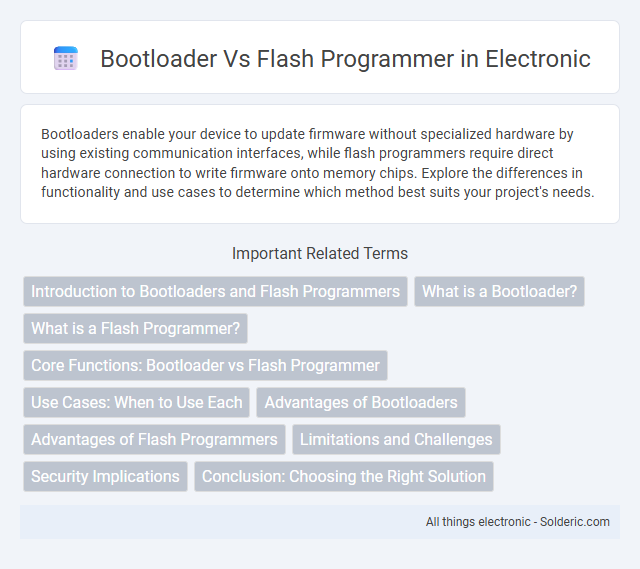Bootloaders enable your device to update firmware without specialized hardware by using existing communication interfaces, while flash programmers require direct hardware connection to write firmware onto memory chips. Explore the differences in functionality and use cases to determine which method best suits your project's needs.
Comparison Table
| Feature | Bootloader | Flash Programmer |
|---|---|---|
| Definition | Firmware component to load application code into memory on device startup. | External tool or software used to write firmware code into flash memory. |
| Function | Enables in-field firmware updates without hardware tools. | Initial programming or firmware update via hardware interface. |
| Usage | Embedded in device memory for self-programming. | Used by developers or technicians during manufacturing or service. |
| Access | Software-driven, communicates via protocols like UART, USB, Ethernet. | Hardware-driven, requires programming interface (e.g., JTAG, SWD). |
| Flexibility | Allows remote or remote-like updates over standard interfaces. | Direct memory access, often faster and more reliable for initial flashing. |
| Complexity | Requires additional firmware code and memory space. | No additional firmware; external programmer handles flashing. |
| Typical Use Cases | OTA updates, field upgrades, boot-time application loading. | Factory programming, recovery, flashing new devices. |
Introduction to Bootloaders and Flash Programmers
Bootloaders are specialized software routines that enable the updating of firmware directly on a device without the need for external programming hardware. Flash programmers are hardware tools designed to write firmware or other data into non-volatile memory like EEPROM or flash chips with precision and speed. Understanding the differences between bootloaders and flash programmers helps you optimize firmware updates for embedded systems efficiently.
What is a Bootloader?
A Bootloader is a specialized software that initializes hardware and loads the main firmware during a device's startup process. Unlike a flash programmer, which directly writes firmware to memory via external interfaces, a bootloader resides within the device and enables firmware updates without needing additional hardware. Your device relies on the bootloader to securely manage system startup and enable seamless software upgrades.
What is a Flash Programmer?
A Flash Programmer is a specialized device or software tool used to write data directly into a microcontroller's or memory chip's non-volatile flash memory, enabling firmware updates or initial programming. It operates at a hardware level, often through protocols like JTAG, SPI, or UART, ensuring precise control over memory content without relying on the device's internal boot sequence. This method contrasts with a bootloader, which is a small program embedded within the device to manage firmware uploads through standard interfaces but depends on existing firmware functionality.
Core Functions: Bootloader vs Flash Programmer
The core function of a bootloader is to initialize hardware and load the operating system or application firmware from non-volatile memory during device startup, ensuring a secure and controlled boot process. In contrast, a flash programmer primarily writes, erases, and verifies firmware directly onto the device's flash memory, often used during development or manufacturing for firmware updates. Bootloaders facilitate in-field updates without specialized hardware, while flash programmers require external tools to manage memory programming.
Use Cases: When to Use Each
Bootloaders are ideal for remote firmware updates, enabling devices to receive new software without physical intervention or specialized hardware, making them perfect for consumer electronics and IoT devices. Flash programmers excel in initial device programming and low-level debugging, providing direct hardware access for development and recovery tasks often required in manufacturing or repair environments. Choosing between a bootloader and a flash programmer depends on the need for field updates versus hands-on device programming and troubleshooting.
Advantages of Bootloaders
Bootloaders enable firmware updates directly on the target device without requiring specialized hardware, reducing both time and cost. They support remote and automated programming, enhancing efficiency in large-scale deployments and minimizing downtime. Your system gains flexibility and ease of maintenance through seamless, in-field firmware updates facilitated by bootloaders.
Advantages of Flash Programmers
Flash programmers offer direct memory access, enabling faster and more reliable firmware updates compared to bootloaders. They support a wide range of devices and can perform in-system programming without depending on the target device's software state. Your development cycle benefits from enhanced debugging capabilities and reduced programming errors when using a dedicated flash programmer.
Limitations and Challenges
Bootloaders face limitations such as restricted memory size and slower data transfer rates, which can hinder large firmware updates and increase update time. Flash programmers offer faster and more reliable programming but require physical access to the device and specialized hardware, posing challenges in remote or embedded system environments. Both methods encounter security challenges, including vulnerability to unauthorized code injection and difficulties in implementing robust authentication mechanisms.
Security Implications
Bootloaders often have inherent security vulnerabilities because they typically allow firmware updates without full authentication, making devices susceptible to unauthorized access or malicious code injection. Flash programmers, by contrast, provide a more secure method for updating firmware using dedicated hardware tools that enforce strict access controls and prevent tampering. Understanding these security implications is crucial for protecting Your embedded systems against potential cyber threats and ensuring device integrity.
Conclusion: Choosing the Right Solution
Choosing between a bootloader and a flash programmer depends on the application requirements and hardware constraints. Bootloaders enable firmware updates over standard communication interfaces without specialized equipment, ideal for remote or frequent updates. Flash programmers offer direct memory access for initial programming and debugging, suitable for development and manufacturing environments where speed and reliability are critical.
Bootloader vs Flash programmer Infographic

 solderic.com
solderic.com